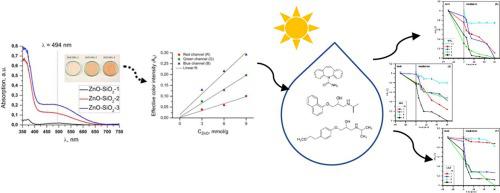Journal of Photochemistry and Photobiology A: Chemistry ( IF 4.3 ) Pub Date : 2021-09-02 , DOI: 10.1016/j.jphotochem.2021.113532 Michael Nazarkovsky 1 , Bożena Czech 2 , Alicja Żmudka 2 , Viktor M. Bogatyrov 3 , Olena Artiushenko 1 , Vladimir Zaitsev 1 , Tatiana D. Saint-Pierre 1 , Rafael C. Rocha 1 , Jiang Kai 1 , Yutao Xing 4 , Wellington D.G. Gonçalves 5 , Amanda G. Veiga 6 , Maria Luiza M. Rocco 6 , Syed Hamza Safeer 7 , Mariia V. Galaburda 3 , Victor Carozo 7 , Ricardo Q. Aucélio 1 , Richard J. Caraballo-Vivas 8 , Olena I. Oranska 3 , Jairton Dupont 5

|
A set of samples of novel colorized zinc oxide-nanosilica composites was synthesized and analyzed. The color and optical properties are directly dependent on ZnO concentration in the composites. Visible light-driven (λ = 550 nm) catalytic activity on the degradation of pharmaceuticals was tested and indicated that the most active sample with 9 mmol of ZnO per 1 g of SiO2 was ca. 13 times (toward propanolol), 24 times (toward carbamazepine) and ca. 37 times (toward metoprolol) more effective than blank (catalyst-free photolysis) decontamination. Besides showing a typical charge transfer band on the UV–Vis spectra, all the samples demonstrated a visible light absorbance at ca. 500 nm. Due to the diminution of ZnO particles size, the sample with the minimal concentration of zinc oxide exhibited pronounced luminescence at the region of >500 nm. The microscopy confirmed the decrease of ZnO agglomerated crystalline phase with diminution of ZnO concentration over SiO2 matrix. XPS studies provided information about the chemical species contributing to the formation of nanocomposites, including the presence of some unexpected trace elements, and also the surface effects of incorporating ZnO nanoparticles into SiO2 matrix also. With the help of elemental analysis, certain impurities in ZnO were identified, which might be responsible for the outstanding optical and catalytic behavior of the samples. The toxicity results confirmed that applied process can be used for detoxification of wastewater.
中文翻译:

具有可见光驱动活性的 ZnO-SiO2 有色粉末的结构、光学和催化性能
合成并分析了一组新型彩色氧化锌-纳米二氧化硅复合材料样品。颜色和光学特性直接取决于复合材料中的 ZnO 浓度。测试了可见光驱动 (λ = 550 nm) 对药物降解的催化活性,表明活性最高的样品每 1 g SiO 2含有 9 mmol ZnO大约是 13 次(对普萘洛尔),24 次(对卡马西平)和约 比空白(无催化剂光解)去污有效 37 倍(对美托洛尔)。除了在 UV-Vis 光谱上显示典型的电荷转移带外,所有样品在约 500 纳米。由于 ZnO 颗粒尺寸的减小,具有最小氧化锌浓度的样品在 >500 nm 区域表现出明显的发光。显微镜检查证实随着 ZnO 浓度相对于 SiO 2的减少,ZnO 团聚晶相减少矩阵。XPS 研究提供了有关有助于形成纳米复合材料的化学物种的信息,包括一些意想不到的微量元素的存在,以及将 ZnO 纳米颗粒并入 SiO 2基质的表面效应。在元素分析的帮助下,确定了 ZnO 中的某些杂质,这可能是样品出色的光学和催化行为的原因。毒性结果证实该工艺可用于废水的脱毒。


























 京公网安备 11010802027423号
京公网安备 11010802027423号